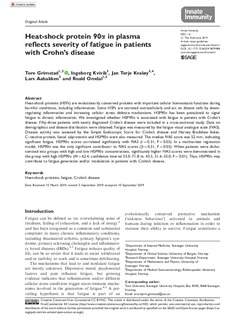| dc.contributor.author | Grimstad, Tore | |
| dc.contributor.author | Kvivik, Ingeborg | |
| dc.contributor.author | Kvaløy, Jan Terje | |
| dc.contributor.author | Aabakken, Lars | |
| dc.contributor.author | Omdal, Roald | |
| dc.date.accessioned | 2020-01-10T13:49:24Z | |
| dc.date.available | 2020-01-10T13:49:24Z | |
| dc.date.created | 2019-11-07T12:48:23Z | |
| dc.date.issued | 2019-10 | |
| dc.identifier.citation | Grimstad, T., Kvivik, I., Kvaløy, J.T. (2019) Heat-shock protein 90α in plasma reflects severity of fatigue in patients with Crohn’s disease. Innate Immunity. | nb_NO |
| dc.identifier.issn | 1753-4259 | |
| dc.identifier.uri | http://hdl.handle.net/11250/2635744 | |
| dc.description.abstract | Heat-shock proteins (HSPs) are evolutionarily conserved proteins with important cellular homeostasis functions during harmful conditions, including inflammation. Some HSPs are secreted extracellularly and act on distant cells by downregulating inflammation and increasing cellular stress defence mechanisms. HSP90a has been postulated to signal fatigue in chronic inflammation. We investigated whether HSP90a is associated with fatigue in patients with Crohn’s disease. Fifty-three patients with newly diagnosed Crohn’s disease were included in a cross-sectional study. Data on demographics and disease distribution were obtained. Fatigue was measured by the fatigue visual analogue scale (fVAS). Disease activity was assessed by the Simple Endoscopic Score for Crohn’s disease and Harvey Bradshaw Index. C-reactive protein, faecal calprotectin and HSP90a were also measured. The median fVAS score was 52 mm, indicating significant fatigue. HSP90a scores correlated significantly with fVAS (r¼0.31, P¼0.03). In a multivariate regression model, HSP90a was the only significant contributor to fVAS scores (b¼0.31, P¼0.03). When patients were dichotomised into groups with high and low HSP90a concentrations, significantly higher fVAS scores were demonstrated in the group with high HSP90a (M¼62.4, confidence interval 53.0–71.8 vs. 43.3, 31.6–55.0; P¼0.01). Thus, HSP90a may contribute to fatigue generation and/or modulation in patients with Crohn’s disease. | nb_NO |
| dc.language.iso | eng | nb_NO |
| dc.publisher | SAGE Publications Ltd. | nb_NO |
| dc.rights | Navngivelse-Ikkekommersiell 4.0 Internasjonal | * |
| dc.rights.uri | http://creativecommons.org/licenses/by-nc/4.0/deed.no | * |
| dc.subject | crohns sykdom | nb_NO |
| dc.subject | kronisk betennelsessykdom | nb_NO |
| dc.subject | fatigue | nb_NO |
| dc.subject | heat-shock protein | nb_NO |
| dc.title | Heat-shock protein 90α in plasma reflects severity of fatigue in patients with Crohn’s disease | nb_NO |
| dc.type | Journal article | nb_NO |
| dc.type | Peer reviewed | nb_NO |
| dc.description.version | publishedVersion | nb_NO |
| dc.rights.holder | © The Author(s) 2019 | nb_NO |
| dc.subject.nsi | VDP::Medical disciplines: 700::Clinical medical disciplines: 750::General internal medicine: 770 | nb_NO |
| dc.source.pagenumber | 1-6 | nb_NO |
| dc.source.journal | Innate Immunity | nb_NO |
| dc.identifier.doi | 10.1177/1753425919879988 | |
| dc.identifier.cristin | 1744924 | |
| cristin.unitcode | 217,8,2,0 | |
| cristin.unitname | Institutt for matematikk og fysikk | |
| cristin.ispublished | true | |
| cristin.fulltext | original | |
| cristin.qualitycode | 1 | |

